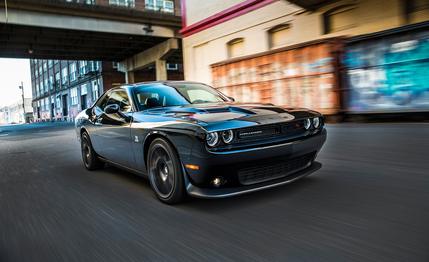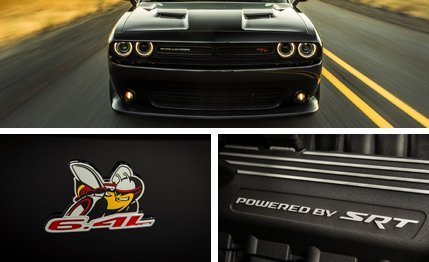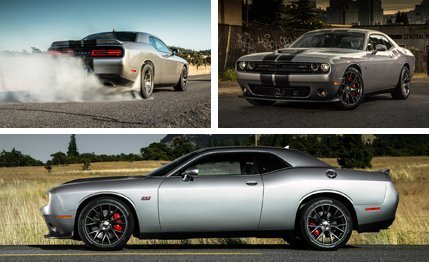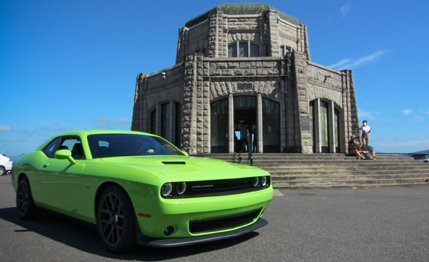 First Drive Review
First Drive Review
Now that the wicked 707-hp Challenger SRT Hellcat is out of the bag, it’s pretty hard to imagine ordering the Challenger any other way. Yet there are several other paths to Mopar bad-assery in the 2015 Challenger lineup. There’s the 305-hp SXT V-6, the 372- or 375-hp R/T model powered by a 5.7-liter Hemi V-8, and the Challenger R/T Scat Pack and SRT 392 models, which feature the previous top-shelf Street and Racing Technology engine, the 6.4-liter Hemi V-8.
With the Hellcat’s obscene output coming courtesy of a supercharged 6.2-liter, the 6.4 is Chrysler’s largest and most powerful naturally aspirated V-8. This year, engineers squeezed out 15 additional horses and 5 more lb-ft of torque for new figures of 485 horsepower at 6000 rpm and 475 lb-ft at 4200. Transmitting power to the rear wheels is your choice of a six-speed manual or a new eight-speed automatic, the latter with steering-wheel paddles that Dodge claims can summon shifts in as quickly as 160 milliseconds.

The historic Scat Pack name was resurrected for Challenger and Charger R/T models just last year and slapped on multistage Mopar performance packages for their shared 5.7-liter Hemi. Now the Scat Pack moniker essentially denotes a Challenger equipped like the cloth-seated R/T but powered by the bruising 6.4. As such, the R/T Scat Pack represents a huge pony-per-dollar proposition, starting at $39,890 with four-piston Brembos at all corners, a performance suspension, and beefy 20-by-9-inch wheels.
For $47,390, the SRT 392 model adds a “Viper-inspired” aluminum hood with a long center-mounted cold-air intake, 9.5-inch-wide Slingshot wheels, massive 15.4-inch front brake rotors with six-piston Brembos, leather seats, an 18-speaker Harman/Kardon audio system, and a one-day driver-training experience hosted by Dodge at select racetracks. The SRT model also features SRT Performance Pages, which not only display real-time vehicle data and ancillary gauges, but also allow the driver to choose different drive modes for the powertrain and chassis. Default, Sport, and Track modes are available to tailor steering effort, the new three-mode adaptive suspension, and the automatic transmission’s shift schedule; each parameter can also be adjusted individually. As before, there also is a full suite of timers to document your own hot-shoe heroics.
Driven back-to-back at Portland International Raceway in eight-speed automatic form, the Scat Pack and the SRT 392 proved virtually identical in terms of on-track prowess. Both offered copious grip and shockingly neutral handling despite weighing more than two tons and packing as much as 55 percent of that mass atop the nose. The broad, flat hood makes any listing behavior quite apparent, and we were mildly surprised at their levels of body control. Turn-in is sharp, and what understeer exists is nicely mitigated by the gas pedal. The tail comes out quickly and easily, even with the stability control on, but it’s easily caught. In the SRT’s Sport mode, there’s more leeway within the stability programming and the electric power steering provides decent feedback. The multi-piston Brembos bolted to both models deliver outstanding stopping power with little to no fade, even after dozens of whirls around PIR.

And of course, the two cars are spectacularly fast. Acceleration is prodigious, and the ZF-designed and Chrysler-built eight-speed automatic always seemed to have the right gear at the ready as we prepared to power out of corners. Dodge expects that the 6.4-equipped Challengers should be able to hit 60 mph in roughly 4.5 seconds and post quarter-mile times in the mid-12s. We saw 60 mph fly by in 4.5 and traveled 1320 feet in 12.9 when we tested a six-speed manual Challenger SRT8 in 2011 upon the 392 engine’s introduction, so those numbers are eminently believable, although we’ll need to strap on our own test equipment to verify them, of course.
We also spent a couple of hours in the SRT 392 on scenic roads tracing the banks of the Columbia River Gorge. On that narrow tarmac, the car was a bit of a handful due to its inescapable mass and its ability to achieve high speed without much effort. The Dodge steered obediently, but confidence on twisty roads is ultimately curtailed by the car’s formidable width and limited outward visibility.
We did appreciate, however, the adjustable suspension, which made what could have been a lumpy ride into a serene one. And the exhaust note, which grows more raucous the deeper one dips into the gas, fades into the background so as not to annoy during extended freeway stints. In all, the Challenger is a much better cruiser than before, which is good since—even with the aforementioned improvements—it’s still no match for the Camaro or Mustang when the road goes all bendy.

The new-for-2015 interior décor is simply fantastic, being ergonomically sound and nicely retro without being kitschy. From the excellent seats to the conical instrument dials and a clear, crisp TFT screen, the interior leaps well past those of previous Challengers in terms of design and quality of materials.
As we said, the Hellcat is the most enticing 2015 Challenger, but these V-8 versions still make sense for horsepower bargain hunters. Just as the range-topper offers supercar power at an agreeable price ($60,990), you’ll be hard-pressed to find anything offering the Scat Pack’s power for less than $40K, even when shopping used. And the SRT 392 can be considered a junior Hellcat of sorts, bringing much of that model’s technological sophistication and features for $13K less. If you’re shopping for a Challenger, that’s a nice chunk of change to put toward fuel and tires. With this much speed and power, you’re going to burn through plenty of both.